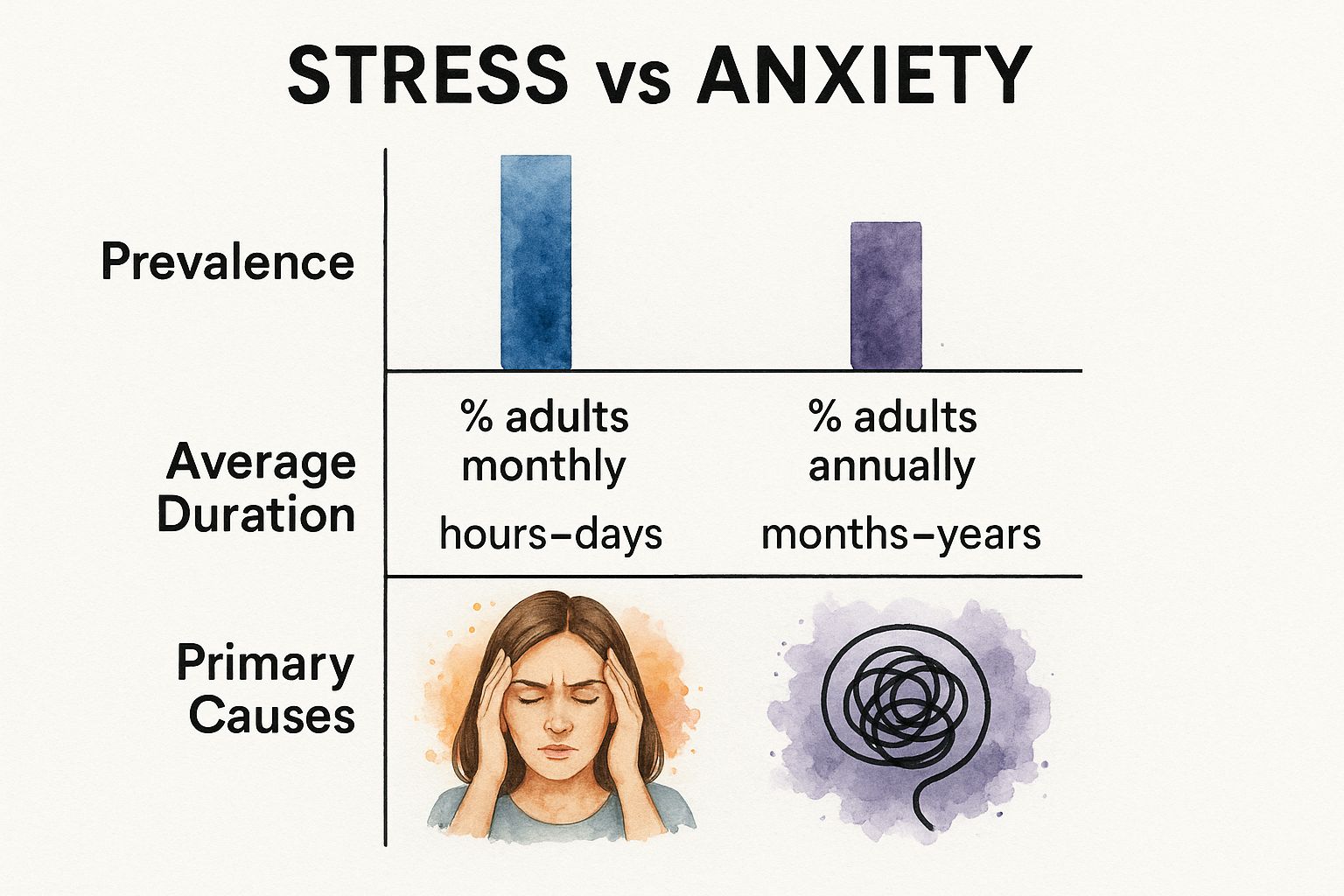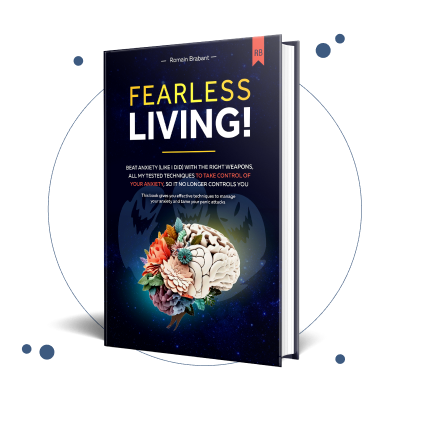
The big difference between stress and anxiety really boils down to this: stress is a reaction to a specific, external trigger, like a looming project deadline. Anxiety, on the other hand, is an internal, persistent worry that sticks around even when there's no immediate threat.
Once that deadline passes or the stressful situation is over, the feeling of stress usually fades. Anxiety, however, can hang around indefinitely, creating a constant sense of unease.
Stress vs. Anxiety: A Clear Comparison
While their symptoms often feel similar, really getting the core difference between stress and anxiety is the first real step toward feeling better.
Stress is your body's natural response to a challenge or demand. Think of it as a short-term reaction that kicks your body’s alert systems into gear—a survival mechanism you can learn more about in our detailed fight-or-flight response guide. This response can even be helpful, giving you the push you need to meet a deadline or perform under pressure.
Anxiety is more like a faulty alarm system that just won't shut off. It’s marked by excessive, persistent worry and fear that can feel overwhelming and get in the way of daily life, even when everything seems fine on the surface.
Figuring out this distinction isn’t just about putting a label on your feelings. It's about realizing that what you're experiencing has a name, a cause, and most importantly, a clear path to healing. Plenty of people learn to manage anxiety and live fulfilling, panic-free lives, and that journey starts right here with this simple understanding.
This infographic below visualizes some key statistical differences in how common they are, how long they last, and what causes them.

The data makes it pretty clear: while stress is a common, short-term experience for most of us, anxiety is a long-term condition that affects a significant number of people every year.
Core Differences Between Stress and Anxiety
To make it even simpler, let's lay out the main distinctions between a typical stress response and a state of anxiety in a quick comparison table.
| Characteristic | Stress | Anxiety |
|---|---|---|
| Primary Trigger | A specific external event or situation (e.g., work deadline, argument). | Often internal; persistent worry, sometimes without a clear cause. |
| Duration | Temporary; subsides once the external trigger is resolved. | Long-term; can last for weeks, months, or even years. |
| Emotional Focus | Frustration and pressure related to the current situation. | A sense of dread, apprehension, and fear about the future. |
This table helps crystallize how a temporary, triggered response (stress) differs from a persistent, internal state of worry (anxiety).
How Each Condition Feels in Your Body
Stress and anxiety both sound the body’s alarm bells, but the way they show up in your physical and emotional life couldn't be more different. Getting clear on these distinctions is the first real step toward finding your way back to calm.
Think of stress as a sudden, intense storm. It’s a direct response to a real-world challenge, and its physical symptoms are usually just as immediate.
The Physical Footprint of Stress
When you’re stressed, your body is literally gearing up for a fight. This feels like a surge of focused—though often uncomfortable—energy. You might notice:
- Muscle Tension: That classic tightness in your neck, shoulders, and back as your body braces itself.
- Headaches: Often tension headaches that feel like a tight band wrapped around your head.
- Stomach Upset: That knot in your stomach or indigestion is your digestive system reacting to the pressure.
- Irritability: A short fuse or a wave of frustration that’s clearly tied to whatever’s causing the stress.
Picture a major presentation looming at work. The tight shoulders, headache, and general annoyance you feel? That’s stress in action. Once the presentation is over, those feelings usually start to melt away.
How Anxiety Manifests Differently
Anxiety, on the other hand, isn’t a storm. It’s more like a persistent, heavy fog that just won't lift. It’s an internal state of unease that often feels completely disconnected from any immediate threat, which is why its physical symptoms can feel so unpredictable and all-consuming.
The feelings anxiety creates can be genuinely alarming, often kicking off a vicious cycle where you start worrying about the symptoms themselves. This is where the crucial difference between stress and anxiety really snaps into focus. Stress is a reaction to a problem; anxiety can feel like the problem itself.
At its core, anxiety often feels like a sense of dread or a constant, baseless fear about the future. It’s the worry that spirals, turning a minor concern into a catastrophic "what if" scenario that feels terrifyingly real in both your mind and body.
This constant state of high alert can do a number on your daily life. For many, this isn't just a small inconvenience. Among adults with a diagnosed anxiety disorder, a staggering 22.8% report serious functional impairment, with another 33.7% experiencing moderate impairment.
Anxiety’s physical calling cards often include:
- Racing Thoughts: An inability to quiet your mind or hit the "off" switch on your worries.
- Restlessness: That on-edge feeling, like you can’t sit still or ever truly relax.
- Panic Attacks: Sudden, intense waves of fear that bring on physical symptoms like a pounding heart, shortness of breath, and dizziness.
These symptoms can make you feel completely trapped, but it's vital to remember that anxiety is highly treatable. Learning targeted techniques, like our recommended breathing exercises for anxiety, can offer immediate relief and is a powerful first step toward regaining a sense of control.
With the right tools and support, it is entirely possible to quiet that internal alarm and live a calm, panic-free life.
Identifying Your Triggers and Root Causes

Figuring out the why behind what you're feeling is one of the most powerful steps you can take to get back in the driver's seat. It's often when you trace your feelings back to the source that the real difference between stress and anxiety snaps into focus.
Think of stress as a reaction to a specific, identifiable 'stressor.' It's almost always a response to an external pressure you can point to—a nightmare project at work, a tense conversation with your partner, or a looming bill. Once that problem is solved, the feeling of stress usually starts to dissolve.
Anxiety, on the other hand, doesn't play by the same rules. It’s sneakier. Its triggers are often more internal, vague, and a lot harder to pin down.
The External Triggers of Stress
Stressors are the concrete problems happening in your life right now. They demand your immediate attention, kicking your body into high alert to deal with the challenge head-on.
You can usually spot them pretty easily:
- Work Demands: That fast-approaching deadline or the difficult feedback you just got from your boss.
- Financial Strain: Worrying about a specific bill that's due next week or dealing with a sudden, unexpected expense.
- Relationship Issues: The fallout from a recent argument or the challenge of navigating a big life change with a partner.
In every case, there’s a clear cause and effect. The event happens, and the feeling of stress follows. It's a direct response to something real and tangible.
The Internal Nature of Anxiety
Anxiety's triggers are a different beast entirely. They tend to live inside your own head—in your thoughts, your fears, and your memories. It loves to latch onto "what if" scenarios that aren't actually happening, creating a persistent, free-floating dread about the future.
This is a critical distinction: stress is about a present-tense threat, while anxiety is often about a perceived future threat. You might feel a wave of anxiety about your career in general, even when you're relaxing on a Sunday afternoon with no immediate danger in sight.
The journey to a panic-free life begins with recognizing that while you can't always eliminate external stressors, you can change your internal reaction to them. Healing from anxiety is entirely possible when you learn to identify and reframe the thought patterns that fuel the fear.
This internal focus is why anxiety can feel so confusing. You might have a racing heart or spiraling thoughts for no obvious reason. To start untangling it all, it can be incredibly helpful to explore some of the more common anxiety triggers that trip so many of us up.
It's also true that chronic, unmanaged stress can pave the way for an anxiety disorder. When your body is stuck in a constant state of high alert from one stressor after another, your mind can learn to expect danger even when there is none. That’s how a series of external pressures can eventually grow into a persistent, internal state of anxiety.
But this isn't a one-way street. With the right strategies and support, you can absolutely learn to manage stressors more effectively and retrain your brain to feel safe and calm again.
The Long-Term Impact On Your Health And Life

We all experience stress. A tough week at work or a family disagreement can leave us feeling drained, but what happens when those feelings stick around? It's important to understand the long-term consequences of unresolved stress and anxiety—not to create fear, but to empower you with the knowledge that a brighter, calmer future is possible.
Recognizing the ripple effects is the first step toward reclaiming your well-being.
Think of chronic stress as a slow, steady leak that gradually wears down your body’s defenses. When your system is constantly swimming in stress hormones, it can set the stage for serious physical health issues down the road.
Anxiety disorders, on the other hand, tend to reshape your world from the inside out. The impact goes far beyond physical symptoms, coloring how you connect with others, chase your goals, and simply move through your day.
How Each Condition Affects Your Well-Being
While they often feel similar in the moment, the long-term footprints of stress and anxiety are quite different. Chronic stress often launches a quiet assault on your body's systems, while an anxiety disorder can fundamentally alter your behaviors and your life's trajectory.
Here's how that often plays out:
-
Chronic Stress often leads to:
- Burnout: That state of total emotional, physical, and mental exhaustion from being "on" for too long.
- Weakened Immunity: Constant exposure to stress hormones can leave you vulnerable to every bug going around.
- Heart Issues: Over time, elevated blood pressure and a racing heart can contribute to serious cardiovascular problems.
-
Anxiety Disorders can result in:
- Social Avoidance: Deep-seated fear and worry can cause you to pull back from friends, family, and activities you once loved.
- Strained Relationships: The constant need for reassurance and the weight of persistent worry can put a heavy burden on your connections.
- Stalled Growth: Avoidance isn't just about social events; it can keep you from taking risks at work or pursuing personal passions.
The most important thing to remember is that these outcomes are not your destiny. Healing is possible. Recognizing these patterns is the first, most powerful step toward breaking the cycle.
Understanding these long-term health implications is crucial. For instance, it's well-documented how anxiety can contribute to arrhythmias as the body remains in a state of high alert. This creates a vicious cycle where the physical sensations of anxiety fuel even more worry.
Long-Term Consequences: Stress vs Anxiety
When you look at the big picture, it's clear how untreated stress and anxiety can pull your life in different directions over time.
| Area of Impact | Chronic Stress | Anxiety Disorder |
|---|---|---|
| Physical Health | High blood pressure, weakened immunity, digestive issues, increased risk of heart disease. | Chronic fatigue, muscle tension, headaches, and physical symptoms that mimic serious illness. |
| Mental State | Leads to burnout, cynicism, and a feeling of being constantly overwhelmed. | Fosters a persistent state of dread, catastrophic thinking, and a feeling of being unsafe. |
| Daily Functioning | Reduced productivity, difficulty concentrating, and irritability that affects work and home life. | Avoidance of people, places, and situations that trigger fear, leading to an increasingly limited life. |
| Relationships | Can cause emotional withdrawal and short-temperedness, pushing loved ones away. | Creates dependency or social isolation due to the fear of judgment or panic attacks. |
The takeaway here is that while both paths lead to poor health, they get there in different ways. Chronic stress slowly erodes your physical foundation, while anxiety actively shrinks your world.
While these conditions are distinct, they are incredibly common. Anxiety disorders are the most prevalent mental health condition worldwide, affecting around 359 million people as of 2021. Stress, on the other hand, is a universal physiological response, but it only becomes a clinical issue when it causes significant impairment.
Learning just how widespread these challenges are can be a relief. You can explore more detailed anxiety statistics to see you're not navigating this alone. The path to a calmer life is well-traveled, and support is out there.
Finding Your Path to Relief and Healing
Okay, so you can tell the difference between stress and anxiety. That’s a huge first step. But what you do with that knowledge is what really counts. This is where you turn understanding into action and start the journey toward a calmer, more present life.
The good news? Managing stress and treating anxiety are both completely possible. The paths are paved with proven strategies that offer real hope for a panic-free life.
The key is realizing they require different toolkits. For stress, the focus is on practical, empowering actions that tackle the external pressures causing the overwhelm. For anxiety, the journey often means getting professional guidance to address the internal patterns that keep the worry machine running.
Empowering Strategies for Managing Stress
Getting a handle on stress is all about regaining a sense of control over your environment and, more importantly, your reactions to it. It’s about building resilience so that external chaos no longer dictates your internal state.
Here are a few powerful places to start:
- Mindfulness and Grounding: These practices are your escape hatch from a stressful thought spiral. They pull you right back into the present moment. Simple techniques, like focusing on your breath or just noticing the feeling of your feet on the floor, can calm your nervous system in real-time.
- Setting Firm Boundaries: Let's be honest, a lot of stress comes from overcommitment. Learning to say "no" when your plate is already full isn't selfish—it's a critical act of self-preservation that protects your mental energy.
- Effective Time Management: Stress loves to make you feel like you're drowning in tasks. The antidote is breaking those huge projects into smaller, bite-sized steps. Suddenly, that looming deadline feels way less intimidating, and you feel like you're back in the driver's seat.
If you're looking for more hands-on ways to decompress, exploring different therapeutic activities for mental health can be a game-changer.
The Hopeful Path to Healing from Anxiety
Anxiety can make you feel completely alone, but the path to healing is a well-traveled one. Millions of people have successfully learned to manage their anxiety and now live full, vibrant lives, free from the grip of panic. Reaching out for help is the bravest first step you can take.
Anxiety disorders are highly treatable, but there's a huge gap in care. In 2021, anxiety disorders affected 359 million people globally, but it's estimated that only about 25% of them actually get the help they need. You can find more details in research from the World Health Organization on global mental health.
If you hear nothing else, hear this: Anxiety is not a life sentence. With the right support and proven therapies, you can retrain your brain, calm your nervous system, and take your life back from worry.
Proven treatments offer a clear way forward:
- Cognitive Behavioral Therapy (CBT): This is one of the heavy hitters in anxiety treatment for a reason. CBT helps you spot, challenge, and reframe the negative thought patterns that fuel the cycle of fear and worry. It gives you practical tools you can use for the rest of your life.
- Medication: For some, medication can be an incredibly valuable tool. It can help regulate brain chemistry and dial down the intensity of anxiety symptoms, which often makes therapy even more effective.
- Psychotherapy: Working with a therapist gives you a safe, supportive space to dig into the roots of your anxiety and build a personalized set of coping strategies. You can learn more about how different types of psychotherapy for anxiety can support you on your healing journey.
Taking that first step—whether it’s trying a one-minute breathing exercise or booking a consultation—is a profound act of hope. It’s the beginning of a life where you are in control, not your anxiety.
Common Questions About Stress and Anxiety
It’s normal to have a ton of questions when you’re trying to untangle the feelings of stress and anxiety. Getting clear, supportive answers is a huge step toward feeling better. It’s about replacing confusion with clarity, and it empowers you with the knowledge that healing isn’t just possible—it’s achievable.
Let's clear up some of the most common questions people have when they're figuring out the difference between stress and anxiety.
Can I Experience Stress and Anxiety at the Same Time?
Absolutely. In fact, feeling both at once is incredibly common.
Think of it this way: chronic stress can be the spark that lights the fire of anxiety. When your body is constantly in high-alert mode from one external pressure after another, your mind can learn to expect danger even when there isn't any.
For example, you might be stressed by a specific, demanding work project. At the same time, you could be dealing with a more general, persistent anxiety about your career that follows you home and hangs around all weekend. Recognizing when a stress response is triggering a broader, more lasting worry is key to seeing the whole picture.
When Does Normal Stress Become an Anxiety Disorder?
The tipping point is usually when the worry becomes persistent, excessive, and feels totally disconnected from a real, identifiable cause. Stress is a reaction to a real problem; anxiety is when that reaction becomes the problem.
If your fear feels uncontrollable and starts getting in the way of your daily life—your job, your relationships, your sleep—it has likely moved beyond a normal stress response. When physical symptoms like a racing heart show up even in calm moments, that’s a clear sign it’s time to seek support.
This shift doesn't mean you're broken; it means you're human. The most hopeful part is that anxiety disorders are highly treatable. Recognizing this change is the first, most courageous step toward reclaiming your life from worry.
What Is the First Step if I Suspect I Have Anxiety?
The single most powerful first step you can take is to talk to a healthcare professional.
Reaching out to your primary doctor or a mental health specialist opens the door to proven, effective treatments that can guide you back to a calmer, panic-free life. This isn't a sign of weakness; it's an act of profound strength and self-care. An accurate diagnosis makes sure there are no other underlying medical issues and sets you on a clear path to healing.
Are Panic Attacks a Symptom of Stress or Anxiety?
Panic attacks are a defining feature of panic disorder, which is a type of anxiety disorder. While an intensely stressful period can definitely trigger a panic attack, the attack itself is a powerful sign of anxiety. It’s a sudden, overwhelming wave of fear that peaks within minutes, often with terrifying physical symptoms.
Unlike a typical stress reaction, panic attacks can feel like they come out of nowhere, not tied to any obvious threat. But even they can be managed. With the right strategies and support, it's entirely possible to understand their triggers and learn how to navigate them, dramatically reducing their power and how often they happen.
At The Anxiety Checklist, we believe a life free from the grip of constant worry isn't just a dream—it's an achievable reality. Our program provides practical, step-by-step tools to help you understand your anxiety and build the skills to overcome it. Take your first step toward fearless living today at https://anxietychecklist.com.

